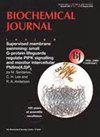Cyanobacterial redox carriers support photosynthesis in a purple phototrophic bacterium.
IF 4.3
3区 生物学
Q2 BIOCHEMISTRY & MOLECULAR BIOLOGY
引用次数: 0
Abstract
In oxygenic and anoxygenic photosynthesis, excitation energy migrates from a surrounding antenna to specialised chlorophyll (Chl) or bacteriochlorophyll (BChl) pigments housed within a reaction centre (RC) complex. Here, a charge-separated state is formed within a few picoseconds, and an electron moves along a series of cofactors until it arrives at a quinone or iron-sulfur centre acceptor. Further photochemical cycles rely on rapid re-reduction of the photo-oxidised RC, usually by small, soluble metalloproteins which vary considerably between different phototrophic clades. In the purple phototrophic bacterium Rhodobacter (Rba.) sphaeroides, the electron carrier cytochrome c2 (cyt c2) shuttles between the periplasmic faces of the cytochrome bc1 complex and the reaction centre-light harvesting 1 (RC-LH1) core complex, the location of the BChl special pair (P865865). By contrast, in the model cyanobacterium Synechocystis sp. PCC 6803, electrons are transferred from cytochrome b6f to photosystem I (PSI) via two isofunctional redox carrier proteins, cytochrome c6 (cyt c6) and plastocyanin (Pc). In this paper, we demonstrate that both cyt c6 and Pc can substitute for cyt c2 in silico, in vitro and in vivo, even though their electrostatic properties may be counter-productive for binding the RC-LH1 complex. Interestingly, whilst P865865++ reduction was highest with cyt c2 and the full physiological RC-LH1 complex, both Synechocystis proteins were more compatible with the RC-only complex lacking the surrounding LH1 antenna. Taken together, this suggests the subunits that constitute the LH1 ring improve both the donor side activity and selectivity of the Rba. sphaeroides RC complex.蓝藻氧化还原载体支持紫色光养细菌的光合作用。
在有氧和无氧光合作用中,激发能从周围的天线迁移到反应中心(RC)复合体内的特殊叶绿素(Chl)或细菌叶绿素(BChl)色素。在这里,电荷分离状态在几皮秒内形成,电子沿着一系列辅因子移动,直到到达醌或铁硫中心受体。进一步的光化学循环依赖于光氧化RC的快速再还原,通常是通过小的、可溶性的金属蛋白,在不同的光养进化枝之间差异很大。在紫色光营养细菌球形Rhodobacter (Rba.)中,电子载体细胞色素c2 (cyt c2)穿梭于细胞色素bc1复合物的质周面和反应中心光收集1 (RC-LH1)核心复合物之间,即BChl特殊对(P865865)的位置。相比之下,在蓝藻Synechocystis sp. PCC 6803模型中,电子通过两种功能相同的氧化还原载体蛋白,细胞色素c6 (cyt c6)和质体青素(Pc),从细胞色素b6f转移到光系统I (PSI)。在本文中,我们证明了cytc6和Pc在体外和体内都可以在硅中替代cytc2,尽管它们的静电特性可能对结合RC-LH1复合物产生反作用。有趣的是,尽管P865865++在cyt c2和全生理RC-LH1复合体中降低幅度最大,但这两种聚囊藻蛋白都与缺乏周围LH1天线的RC-only复合体更相容。综上所述,这表明构成LH1环的亚基提高了Rba的供体活性和选择性。球形碳化物RC络合物。
本文章由计算机程序翻译,如有差异,请以英文原文为准。
求助全文
约1分钟内获得全文
求助全文
来源期刊

Biochemical Journal
生物-生化与分子生物学
CiteScore
8.00
自引率
0.00%
发文量
255
审稿时长
1 months
期刊介绍:
Exploring the molecular mechanisms that underpin key biological processes, the Biochemical Journal is a leading bioscience journal publishing high-impact scientific research papers and reviews on the latest advances and new mechanistic concepts in the fields of biochemistry, cellular biosciences and molecular biology.
The Journal and its Editorial Board are committed to publishing work that provides a significant advance to current understanding or mechanistic insights; studies that go beyond observational work using in vitro and/or in vivo approaches are welcomed.
Painless publishing:
All papers undergo a rigorous peer review process; however, the Editorial Board is committed to ensuring that, if revisions are recommended, extra experiments not necessary to the paper will not be asked for.
Areas covered in the journal include:
Cell biology
Chemical biology
Energy processes
Gene expression and regulation
Mechanisms of disease
Metabolism
Molecular structure and function
Plant biology
Signalling
 求助内容:
求助内容: 应助结果提醒方式:
应助结果提醒方式:


